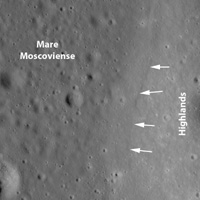
Click on the image for annotated versionThe edge of Mare Moscoviense. Image width is 1.4 km
Mare Moscoviense is a one of the many places on the lunar surface that lunar scientists want to visit. The lunar farside is quite different from the nearside; one of the bigger reasons why is that the mare basalt deposits so common on the nearside are few and far between on the farside. Since basalts form by partial melting of the lunar mantle, sampling Moscoviense basalts would provide lunar scientists with vital insights into how the lunar mantle on the farside differs from the nearside mantle, which in turn would help us to learn why mare basalts are so much rarer on the farside. The white arrows in Figure 1 show the location of a "bathtub ring" indicating the level that the original lavas reached as the Moscoviense basin filled with lava. As time progressed, the erupted lavas gradually drained out of the basin, eventually solidifying at the current lower level.
NASA's Goddard Space Flight Center built and manages the mission for the Exploration Systems Mission Directorate at NASA Headquarters in Washington. The Lunar Reconnaissance Orbiter Camera was designed to acquire data for landing site certification and to conduct polar illumination studies and global mapping. Operated by Arizona State University, the LROC facility is part of the School of Earth and Space Exploration (SESE). LROC consists of a pair of narrow-angle cameras (NAC) and a single wide-angle camera (WAC). The mission is expected to return over 70 terabytes of image data.
